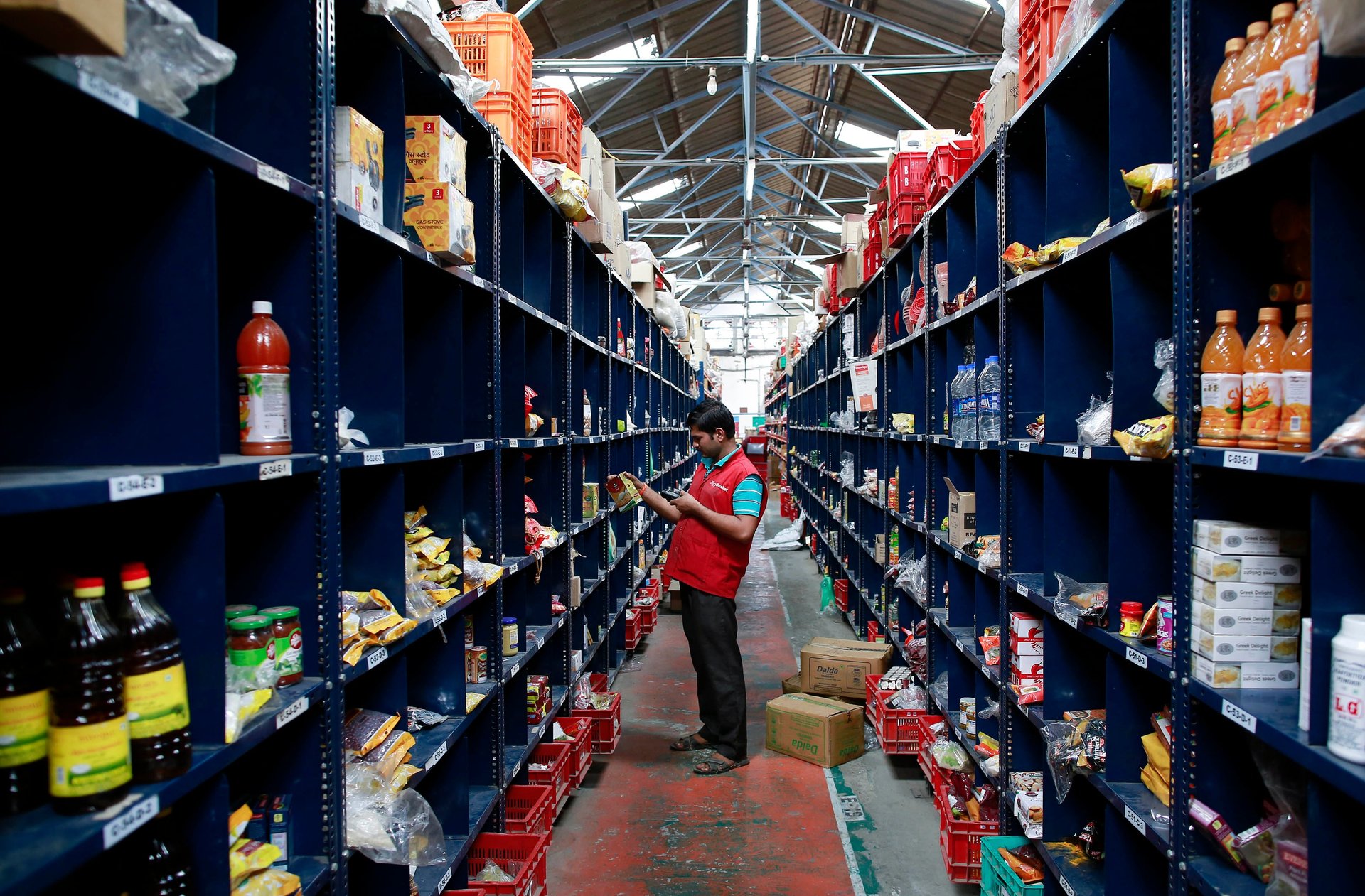India’s online grocers bet on innovation to fend off Amazon, Flipkart
Amazon and Flipkart are making life hard for the smaller Indian online grocery retailers.


Amazon and Flipkart are making life hard for the smaller Indian online grocery retailers.
So the incumbents of this high-volume segment are getting innovative, experimenting with new products and concepts, to survive the onslaught of the new deep-pocketed rivals.
For instance, Bengaluru-based BigBasket, one of the two biggest online grocery retailers in India, plans to launch a subscription service wherein customers can order milk and a few other daily essentials the previous night and have them delivered the following morning. Gurugram-based Grofers, the other big player, is betting on the group-buying concept, where customers can get steep discounts and lucrative deals on making bulk purchases.
Why groceries?
Selling groceries online is still a fairly new concept in India.
The segment accounts for less than 1% (pdf) of overall e-commerce in the country. However, it is also the fastest-growing one with an estimated compounded annual growth rate of 62% between 2016 and 2022. By 2020, online retail is expected to make for 2% of the overall grocery sales (pdf) in India, creating a potential market size of around $10 billion (Rs60,000 crore), according to a report by International Organisation of Scientific Research.
No wonder Flipkart and Amazon are pulling out all the stops.
“Grocery is a low-margin business, but the frequency of transactions is high because it is an essential purchase for any household,” Sreedhar Prasad, a partner at business consulting firm KPMG, said. “Groceries is the next logical step for e-commerce companies with a large customer base.”
So in May, armed with an investment from Walmart, Flipkart launched its own brand, Supermart, but only for Bengaluru. The store now handles an average of around 300 orders per day. The company is looking to enter other markets such as Delhi, Hyderabad, and Chennai by the year-end. It has also launched Flipkart Supermart Select, a private label for household staples such as food grains, lentils, and oil.
Flipkart has set up a network of warehouses and last-mile delivery logistics and is also experimenting with delivery of open boxes to make it easier for a consumer to return an item on the spot. With a dedicated fulfillment centre for grocery spread across 150,000 square feet in Bengaluru, the company currently has 10,000 stock-keeping units.
Amazon, on the other hand, has already tasted success in its international markets, primarily the US.
In India, the company has been operating a grocery business since 2015 but began marketing it aggressively after it re-branded the vertical as Prime Now in May. Since then, Amazon has committed $500 million to the venture. It also has the approval to open brick-and-mortar stores in India.
Such heightened activity has nudged BigBasket and Grofers into action, too.
In February, BigBasket raised $300 million in funding from Alibaba and other investors, while Grofers raised $60 million in a round led by SoftBank in March.
The two companies are now using these funds to carve out their niche.
Innovating their way
Founded in 2011, BigBasket is the segment leader (pdf) with around 35% market share, processing over 50,000 orders daily through 25 collection centres across the country.
The company is focusing now on inorganic growth to maintain its lead.
Over a period of just five months, it has made at least three acquisitions—RainCan and Morning Cart for milk delivery, and smart vending machine startup Kwik24—to capture the delivery market for micro-sized orders such as one packet of milk daily.
BigBasket is also looking to expand its presence in the offline space with kiosks selling staples such as milk and bread at apartment complexes. It has a separate service called BB Express, delivering products to users within two hours of placing an order; this service is currently functional in all markets that the company has a presence in.
On the other hand, Grofers pivoted to the high-margin private label business instead of just curation in 2016, two years after its launch. The company sells tea, tomato ketchup, corn flakes, detergents, tools, and more under seven private label brands, including G Mother’s Choice, G Happy Day, HaveMore, and SaveMore.
In addition, Grofers is betting on group buying to lure consumers. Under the programme, the company negotiates better prices on products if there are a number of people ready to buy it. The average cart size under the service is about Rs1,100. The company has entered into exclusive tie-ups with brands across categories to negotiate cheaper deals.
However, it is still unclear if all this would be enough.
Power struggle
Analysts believe it’s not a cake walk for Flipkart and Amazon despite their financial muscle.
“The business is challenging, with low margins, which means less room for discounts. It needs a dedicated focus on core offering and quality while creating assets around it, which is difficult in a marketplace model,” said Ankur Bisen, senior vice-president at management consulting firm Technopak Advisors. “Quality and timely delivery are crucial to grocery business more than any other business.”
But, Amazon and Flipkart are not far behind in the race, says Meena of Forrester Research.
“These players are aware of these challenges and are, therefore, investing in technology and acquisitions to fill the gap. They are addressing these issues and given their deep pockets and technology assets, it will be difficult for pure-play e-grocers to compete against them.”
The sector has seen several casualties over the years because of execution failures. For instance, PepperTap shut shop in 2016 and LocalBanya shuttered in 2015 after users complained of inconsistency in the quality and availability of products.
The war is on. And at the end of the day, customers will enjoy the spoils.